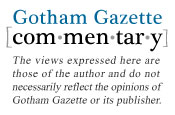
New York needs a five-year plan to address its structural budget imbalance.
Because the New York State budget crisis emerged during a national recession, people often think that the budget gaps are a result of the recession and that when the economy rebounds, the crisis will be over. However, the problems facing New York go far beyond the recession and require solutions that will last even after the present downturn is over. The state is facing a long-term structural budget gap.
The idea of a "structural gap" separates the deficits that occur because of economic ups and downs and extraordinary crises from the deficits that occur because state expenditures outpace state revenues year after year, in good and bad economic times. The distinction between deficits caused by economic downturns and structural deficits can be seen in the current New York budget crisis.

For 2010-2011, the state Executive Budget anticipates a deficit of around $8 billion (since the submission of the budget, the estimated gap has widened). However, the Executive Budget arrives at its $8 billion figure only after including almost $10 billion in temporary revenue items such as tax increases and federal stimulus money. Once the budget gap is adjusted to remove these temporary items, it totals around $18 billion. We estimate that approximately $5 billion to $5.5 billion of the $18 billion gap comes from revenue declines and spending increases related to the recent recession. However, that means we still must address a "structural gap estimated at more than $13 billion to address. Better economic times, in and of themselves, will not solve this $13 billion gap.
Addressing the structural imbalance
Many New Yorkers do not yet understand the severity of the structural imbalance, but it has placed New York in a fiscal position that is not sustainable. Recently I released a report titled,Five Year Plan to Address the New York State Budget Deficit. The report outlines changes in state budgeting that I believe are needed to achieve and maintain structural balance in the state budget. These proposals must be treated as an integrated whole, not a list of options. To work, they all must be adopted together. The figure below provides highlights of the report’s recommendations.
Five-Year Plan for Structural Balance: Key Recommendations
(1) Lock state into paying down its structural gap within five years.
(2) Require quarterly assessment of structural balance by an independent Financial Review Board.
(3) No balance triggers reductions: Authorize the governor to implement across-the- board reductions if the independent review board finds that the budget is not projected to be in balance at year's end and the governor and the legislature cannot agree on gap-closing actions within a limited time-frame.
(4) Permit borrowing with stringent limits. Allow the state to borrow within defined limits to close existing budget gaps, but only if the independent review board finds that strict new financial controls have been met.
(5) Adopt Generally Accepted Accounting Principles for accounting.
Essentially the report recommends that the state close its structural budget gaps within five years. To do so, the state should institute a five-year planning process that identifies the gaps, sets out initiatives every year to bring the state closer to its five-year goal and shows the budgetary consequences of these initiatives in the current year and following years.
The report also recommends that the budget balance achieved by the five-year plan should be measured not on a cash basis but under Generally Accepted Accounting Principles, or GAAP, as applied to governments, which requires that revenues be recognized when they are actually earned, as opposed to when the money happens to arrive, and that expenditures be recognized when the liabilities are incurred, rather than when the government decides to write the check. These principles have become the standard for accurate financial reporting in both the public and private sectors.
The report also suggests that the five-year plan be updated on a quarterly basis and reviewed by an independent review board. The board will make a finding on whether the plan, as updated, is making adequate progress toward structural budget balance. If there is not adequate progress, the governor and the legislature will be compelled to take corrective action to bring the budget back toward balance. If the governor and the legislature do not agree on corrective action within a limited time, the governor would be authorized to make across-the-board spending reductions.
Borrowing is permitted under the plan if, and only if, the board finds that the plan will be in balance under Generally Accepted Accounting Principles by the fifth year of the plan. If these conditions are satisfied, the state would be permitted to borrow small and declining short-term amounts over the shortest possible period to mitigate the pain of any spending cuts or revenue measures required to move towards balance.
Risks and Benefits
If we do nothing, the current budget system will continue to impose large and increasing risks on the state, including the erosion of vital services on which citizens depend and the state's capacity to invest in its future. In contrast, while the changes proposed in the plan will not be easy or painless to implement, the long-tem results will be far more beneficial to all New Yorkers.
In the 1970s, when New York City faced a grave fiscal crisis, the state instituted financial rules similar to those described in the plan. The new rules are one reason for the city’s remarkable recovery. In the city’s emergency, the state recognized what it takes to bring a government back from chronic fiscal incapacity. Today, I am confident that we are capable of doing no less for the state as a whole.
Richard Ravitch is lieutenant governor of New York state.




